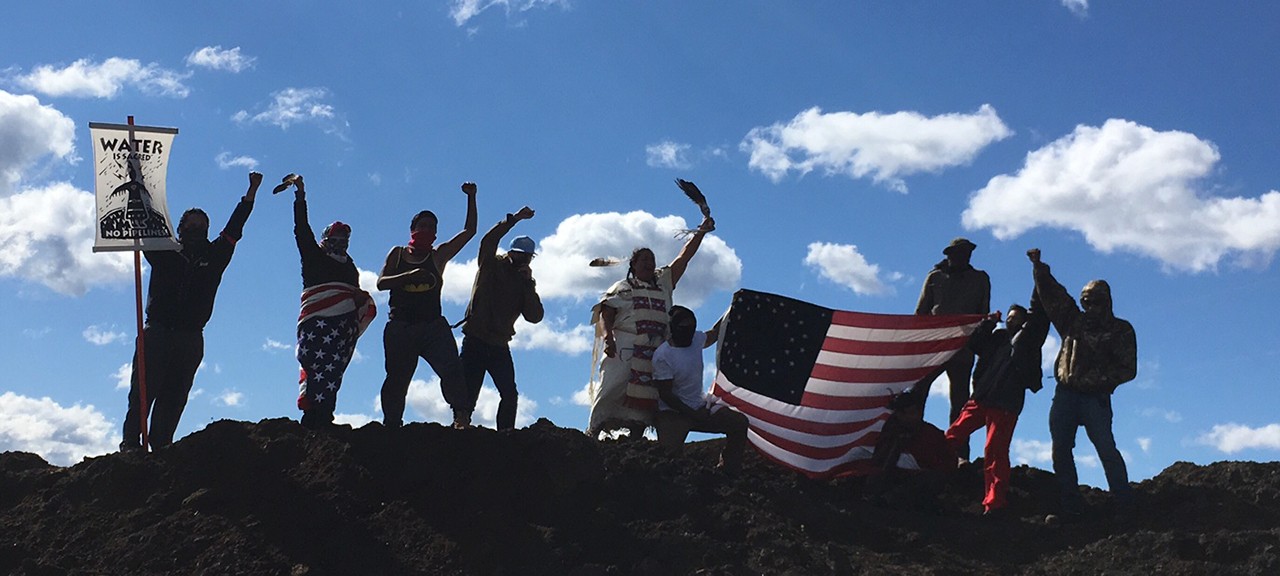Submitted by Kai Sanburn
I went to Standing Rock in September, and the pull was strong to go again.
When I first got there, in the company of fellow Lopezian Irene Skyriver we were touched by the warm welcome as we stood at the sacred fire. There, I slept and woke through nights of distant drumming and song, chopped vegetables and watched the planting of young corn in the path of an oil pipeline snaking miles across the land. I stood among men and women dressed in camouflage singing their prayers and invoking ancestral wisdom.
When the water protectors, as they call themselves, put out a second mobilization call, I was glad to be able to say yes. I’m headed back there now, as I write this.
Standing Rock is a reservation of the Lakota Sioux in North Dakota, located along the banks of the Missouri River. But in the headlines, Standing Rock has become shorthand for a news-making, months-long demonstration, an encampment that has won support around the globe for its determined and peaceful resistance to the Dakota Access Pipeline (DAPL).
Background
The DAPL is a 1,174-mile project that would, on completion, carry 470,000 barrels of crude oil from the Bakken fracking fields in northwest North Dakota across three states to Illinois where other pipelines would be used to carry the oil to Gulf Coast refineries. The processed oil would then be shipped offshore to be burned in other countries.
The issue for the Lakota Sioux is the fact that the state of North Dakota adjusted the pipeline’s route in order to move it from its planned crossing of the Missouri River at a point close to the capital city of Bismarck, to a new location further south, along the river, this one just a half-mile upstream from the point where the Standing Rock reservation draws its drinking water.
Back in April, a handful of elders and warriors pitched camp along the river to offer prayer and ceremony — to defend the river, their sole source of water and all they hold dear. The river forms Standing Rock reservation’s eastern border for approximately 50 miles.
“Water is Life,” is the Lakota Sioux’s simple call to arms.
They understand the intolerable risks of pipeline rupture and leakage. The pipeline hasn’t been made any safer, they say, it was simply moved south, closer to reservation land and away from populous Bismarck. This comes as no surprise to people accustomed to living in areas deemed ‘sacrifice zones’ by powerful economic interests.
To date, more than 300 tribes and indigenous peoples from around the globe have come to Standing Rock to express solidarity with the Lakota Sioux. Age-old hostilities have melted away in favor of solid, common ground. Powerful alignments between U.S. tribes and others have been formed, linking indigenous movements around the globe. The encampment has hosted up to 5,000 people at one time; usually, there are as many as 2,000 people holding vigil.
Tents, make-shift structures and tipis, some elaborately painted, are strewn across the brown undulating landscape. Golden cottonwoods blaze along the riverbeds. Hundreds of banners and flags snap in the prairie winds. Horses whinny, wood smoke rises. It feels both ancient and new.
Resistance to the pipeline comes from many quarters beside the Lakota Sioux. Landowners along the route have lost large swathes of farmland through eminent domain; lawsuits have been filed. But the crux of the legal battle has been the federal permit that green-lights the project’s tunneling beneath the Missouri River. The U.S. Army Corps of Engineers is currently reviewing the permitting process due to the absence of legally mandated participation of the Lakota Sioux nation in the original deliberations — tattered treaty rights seem to have some power still.
The energy of Standing Rock has gone viral. The violent police response toward unarmed people has intensified international sympathy. Solidarity actions proliferate globally. People on Lopez held a well-received, 96-hour vigil. Every Wednesday at the Lopez Library, Liz Lafferty hosts a letter writing campaign to support the peaceful Standing Rock warriors. I’m carrying care packages and messages of support from caring islanders. I’m grateful to be such a courier.
It’s hard to know what the outcome will be, whether oil with flow through that pipeline or not; whether the pipeline’s path will, once again, be adjusted. But it’s clear that something compelling has been born along the banks of the Missouri and broadcast far and wide: a pact to honor the earth and each other, the recognition of the supreme value of pure water. We know this, even here in the water-rich northwest, the value of the water from our wells. This is true for everyone, and it’s a truth worth standing up for.



